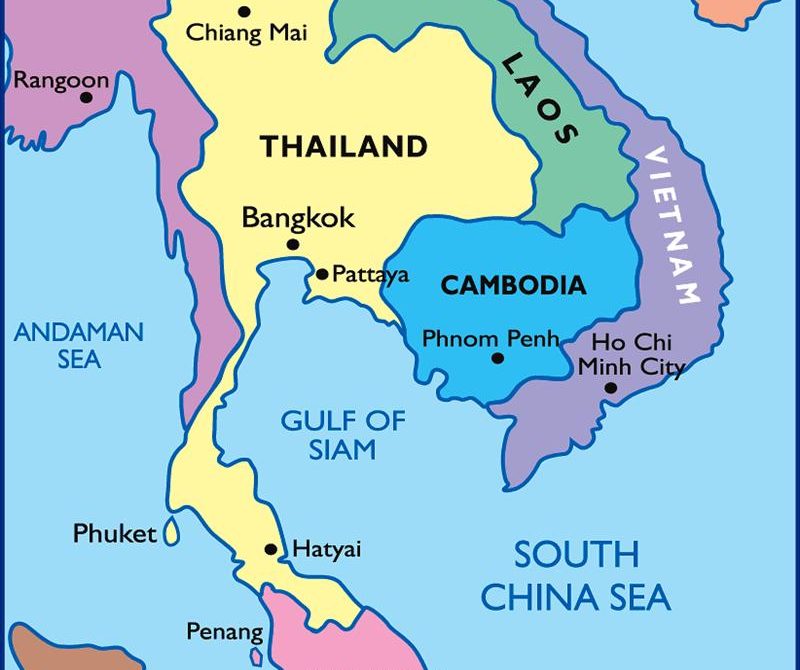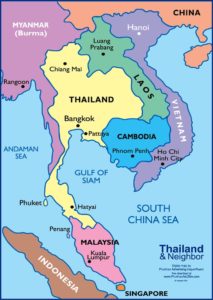
We are compelled to study the operational business models of golf courses around the world. February took us on a 19-day tour to Bangkok, Siem Reap, Danang, Hanoi, and Seoul. Culturally stimulating, intellectual enriching and while not necessarily relaxing, we found the service level nearly identical at each facility. It was outstanding. Warm greetings upon entering, impressive locker rooms, well-stocked pro shops, trained caddies, courses maintained without chemicals, appropriate on course facilities and cooling towels upon completing the round were consistent amongst all facilities.
Thai Country Club, Nikanti, Ayodhya Links,(Thailand) Angkor Golf Resort, Phokeetra Golf (Cambodia), Montgomerie Links, Ba Na Hills, BRG Danang Golf, Van Tri (Vietnam) and Haesely Nine Bridges (South Korea), each share things in common that might provide US course managers a valuable lesson.
The assembly line of golf consists of:
- Caddies are waiting upon your arrival at the main entrance. Your clubs are “inventoried” with a tag placed on your bag with the caddie signature.
- You are escorted to the pro shop to register in which a locker key is provided. This locker key serves as your member number for the day. Using the locker key number, you can charge for items in the pro shop, at on course facilities and in the restaurant.
- Locker rooms have suntan lotion, other anticipated amenities and are staffed.
- 45 minutes is allocated to warm up on the driving range, short game area and putting green.
- Caddies are often assigned one per person per cart.
- Green fees ranged from $75 to $125. Caddy fees are $15 to $20.
- The order of play is sometimes determined by drawing metal chopsticks out of a cylindrical jar.
- On course facilities featuring a bevy of food and drink are available around the 5th and 14th holes.
- Golf course conditions are very good considering that each facility prides itself on being “environmental stewards” in which no chemicals are used to maintain the course.
- Cool towels are provided upon the completion of the round.”Halfway Houses.”
- The clubs are re-inventoried by the caddie, packed into your traveling club bag and automatically loaded in the transportation being used.
- After frequenting the restaurant, one checks out at the concierge settling outstanding charges with a credit card.
There is a saying a picture is worth a 1,000 words, here are some photos to bring these practices to life.
Golf Courses
Angkor Golf Resort – Download
Ayodhya Links – Download
Ba Na Hills Golf Resort – Download
BRG Danang Golf Club – Download
Montgomerie Golf Links – Download
Nikanti Golf Resort – Download
Phokeetra Golf Links – Download
Thai Country Club – Download
Van Tri Country Club – Download
Scenery
Angkor Tom, Angkor Wat – Download
Bangkok – Download
Danang – Download
DMZ – South Korea –Download
Golden Bridge – Download
Halong Bay – Download
Hoi An – Download
Siem Reap – Download
Sofitel Siem Reap – Download
Thailand Country Side – Download



Bill Healey
Quite a nice journey you made through SE Asian golf courses. I’ve been fortunate to have played most of the courses. A few of my favorites include Phokeethra Golf Resort and Angkor Golf Resort in Siem Reap, and the courses in Danang … one of SE Asia’s top golf destinations. I was fortunate to have been part of the course review team for Vietnam Golf Magazine back in 2015, with each of the course summaries (with photos) posted at https://vietnamsbestgolf.blogspot.com/.
JJ Keegan
Thank you for taking to respond to the article. I greatly respect your opinion and you are correct. Labor and the benefits paid in Southeast Asia provide a very competitive advantage. However, I believe there is more to the story that reflects the ability of these golf courses to generate a profit. First, staffing levels in Administration, Maintenance, Pro Shop and the Restaurant are comparable to US benchmarks. More importantly, according to the National Golf Foundation 2018 State of the Industry report, the average US golf course realizes $34 per round. In contrast, in Southeast Asia, with green fees ranging from $75 to $125, based on 20,000 rounds, they averaging REVPAR I suspect of about $55. Despite their cost advantages, they are not willing to discount based on the superior experience provided. To illustrate, in Siem Reap, Cambodia where the average annual wage if $3,000, an annual membership at Angkor Golf Resort (a fabulous Nick Faldo designed golf course) is $2,500. The course is magnificently maintained and the smaller clubhouses observed in Asia provide other cost savings. The real fulcrum that drives golf in Asia is that most of the golfers are tourists from China, Korea, US, and Japan in that order. Being a “resort” provides the flexiblity to offer a heightened golf experience and a less sensitive by the golfer to the prices being charged.
What I find curiously compelling is what if US public golf courses offered lockerooms and key creating the “member for the day” experience. Would be interesting if those added amenities would change the financial results here in the US where the NGF projects that 150 golf course should close annually until 2030 for demand and supply to reach equilibrium.
If you would like to discuss the matter further, I welcome your call and appreciate your thoughts. JJK
Rick Robshaw
Great insight and spot on that most play is from tourists on holiday. I think the maintenance numbers may be misleading (again only speaking of Thailand)… the caddies are typically part of the course maintenance team there. if they do not get a bag to loop, they are typically sent out on the course to pull weeds, care for flower beds, etc. The other thing i have observed at many clubs there is at the end of the day, groups of caddies will split up and walk the fairways fixing divots while others will be assigned to the greens to fix ball marks. i am guessing these folks are not included in the maintenance headcount.
There is one other factor that comes into play (at least in the Thai market) but that is a private conversation over a beer. There are also many Thai courses you can play in the $30-$50 range. I know of one excellent high end public course here in PA (Olde Stonewall) that does offer lockers (though not the whole Asia experience) but i have noticed every time i have been there, the locker room was empty. Likely just a coincidence.
Rick Robshaw - Club Prophet Systems
Nice trip… Nikanti is one of my favorites. Also happens to be a Club Prophet Systems client and the Caddy rating system was developed for them by CPS. We also developed a complete “Passport” system for the process you used at Danang for our Vietnam clients. Would love to see some of the practices in SE Asia carried over to the States. Unfortunately the cost of labor makes much of that prohibitive.